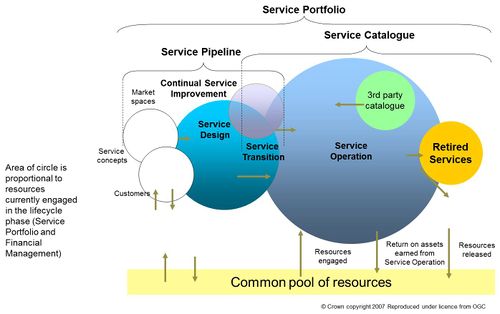ITIL
IT Infrastructure Library
Service Strategy
For example the long-term plan for a company
- What services should we offer and to whom?
- How do we differentiate ourselves from competing alternatives?
- How do we truly create value for our customers?
- How do we capture value for our stakeholders?
- How can we make a case for strategic investments?
Service Design
Design the services in the service strategy
- Design services to satisfy business objectives, based on the quality, compliance, risk and security requirements
- Design services that can be easily and efficiently developed and enhanced
- Design efficient and effective processes for the design, transition, operation and improvement of high-quality IT services
- Identify and manage risks so that they can be removed or mitigated before services go live
- Design measurement methods and metrics for assessing the effectiveness and efficiency of the design processes and their deliverables
Service Transition
This is the phase where IT buys, builds, tests, and ultimately installs and deploys services. This is where the action happens; up until this point, IT hasn’t been able to tinker with gadgets like servers, routers, switches, circuits, applications, and the like. Service Transition is where IT gets its hands dirty
- Introducing new (or changed) services in the production environment.
- Moving services from the Design phase into the production environment, while ensuring that there is minimal impact on existing services.
- Ensuring that there are clear and comprehensive transition plans.
- The retiring of services no longer needed.
- The transfer of service to an external provider or bringing a previously outsourced service back in-house.
Service Operation
The purpose of Service Operation is to coordinate and carry out the activities and processes required to deliver and manage services at agreed levels to business users and customers.
Service Operation embodies five processes and four functions, as outlined in Table 5-1. Service Operation is the only core publication that describes functions.
| Processes (What gets done) | Functions (Who does it) |
|---|---|
| Event Management | Service Desk |
| Incident Management | Technical Management |
| Reguest Fullfillment | Application Management |
| Problem Management | IT Operations Management |
| Access Management |
CSI - Continual Service Improvement
Continual Service Improvement (CSI) provides guidance on how to identify ways to improve process progress, effectiveness, efficiency, and cost-effectiveness (PEEC).
Review, analyze, and make recommendations on improvement opportunities in each lifecycle phase:
- Service Strategy, Service Design, Service Transition, and Service Operation.
Service portofolie management
Service portofolio management spans across the total length of the service lifespan.

Links
Links
- OTRS open-source Help Desk and IT Service Management (ITSM) solution